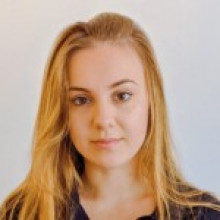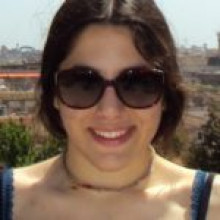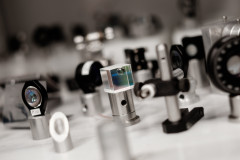Research directions / Objectives
Mission Statement
To explore the unprecedented potential of matter-wave interferometry
To look at (de)coherence in increasingly complex quantum systems.
The three experiments:
BEC 1: Coherently guided matter-wave interferometry. Our matter-waves will be made from Bose-Einstein Condensates (BEC). The interferometer will consist of a novel magnetic ring-shaped waveguide based on time-averaged adiabatic potentials (TAAP). A little 'teaser' movie of our TAAP can be seen here. With this experiment we are part of the Marie Curie Initial Training Network QTea (395k€), where we are developing the next generation of guided matter-wave interferometers. We are also the coordinators of the MatterWave network (a FET-STREP 2013-2017 network by the EU Total 2.6M€ of which IESL will get 652k€).
BEC 2: Atom Lasers and BEC at high atom numbers. We have set up a second experiment, which looks at BEC at higher atom numbers. Here, we have recently demonstrated a novel atom laser, which has a record flux of 4x10^7 atom/s. We also made the coldest thermal source to date (200nK). We are currently exploring the phase properties of atom lasers.
In the future we plan to study the kinetics of the condensation process itself, as well as the rise and fall of coherence in phase-fluctuating condensates.
BEC in space: Testing the equivalence principle. We are the coordinators of the Greek contribution to the STE-QUEST mission to send a BEC into space. The idea of the mission is to test Einstein’s equivalence principle, which states that the mass of acceleration and attraction are the same. Our part will be to design and construct the optical switching board at the center of the mission. The mission is a pan-European effort lead by Prof. Rasel from Hannover.
HIGHLIGHTS
Awards and Prizes
2005: ‘Certificate of Excellence‘
of the
Young Scholars Competition, University of Berkeley
2006: Marie-Curie Excellence Grant (MatterWaves)
Scientific Highlights
2009 The first Bose-Einstein Condensate of South-Eastern Europe
2013 By one order of magnitude the brightest atom laser ever
LATEST PAPERS
Saurabh Pandey, Hector Mas, Georgios Vasilakis, and Wolf von Klitzing
Atomtronic Matter-Wave Lensing
Physical Review Letters 126:17 (2021) https://doi.org/10.1103/physrevlett.126.170402
Saurabh Pandey, Hèctor Mas, Giannis Drougakis, Premjith Thekkeppatt, Vasiliki Bolpasi, Georgios Vasilakis, Konstantinos Poulios, and Wolf von Klitzing
Hypersonic Bose--Einstein condensates in accelerator rings
Nature 570:7760 205--209 (2019) https://doi.org/10.1038/s41586-019-1273-5
Research Topics

RESEARCH DIRECTIONS / OBJECTIVES
Mission Statement
To explore the unprecedented potential of matter-wave interferometry
To look at (de)coherence in increasingly complex quantum systems.
The three experiments:
BEC 1: Coherently guided matter-wave interferometry. Our matter-waves will be made from Bose-Einstein Condensates (BEC). The interferometer will consist of a novel magnetic ring-shaped waveguide based on time-averaged adiabatic potentials (TAAP). A little 'teaser' movie of our TAAP can be seen here. With this experiment we are part of the Marie Curie Initial Training Network QTea (395k€), where we are developing the next generation of guided matter-wave interferometers. We are also the coordinators of the MatterWave network (a FET-STREP 2013-2017 network by the EU Total 2.6M€ of which IESL will get 652k€).
BEC 2: Atom Lasers and BEC at high atom numbers. We have set up a second experiment, which looks at BEC at higher atom numbers. Here, we have recently demonstrated a novel atom laser, which has a record flux of 4x10^7 atom/s. We also made the coldest thermal source to date (200nK). We are currently exploring the phase properties of atom lasers.
In the future we plan to study the kinetics of the condensation process itself, as well as the rise and fall of coherence in phase-fluctuating condensates.
BEC in space: Testing the equivalence principle. We are the coordinators of the Greek contribution to the STE-QUEST mission to send a BEC into space. The idea of the mission is to test Einstein’s equivalence principle, which states that the mass of acceleration and attraction are the same. Our part will be to design and construct the optical switching board at the center of the mission. The mission is a pan-European effort lead by Prof. Rasel from Hannover.
HIGHLIGHTS
Publication
2019: Nature Publications: Hypersonic Transport of Bose-Einstein Condensates in a Neutral-Atom Accelerator Ring (https://doi.org/10.1038/s41586-019-1273-5)
Awards and Prizes
2005: ‘Certificate of Excellence‘
of the
Young Scholars Competition, University of Berkeley
2006: Marie-Curie Excellence Grant (MatterWaves)
Scientific Highlights
2009 The first Bose-Einstein Condensate of South-Eastern Europe
2013 By one order of magnitude the brightest atom laser ever








































